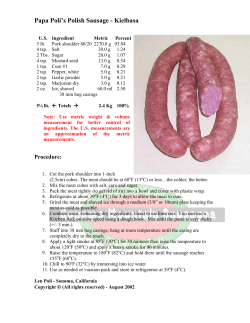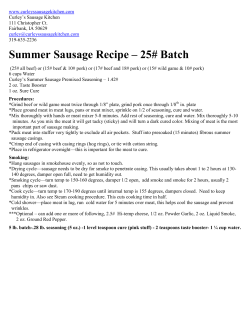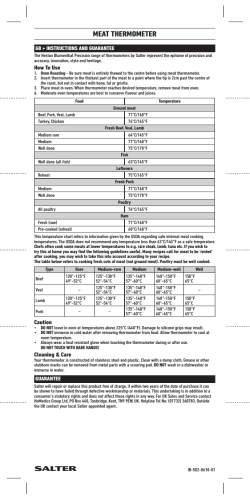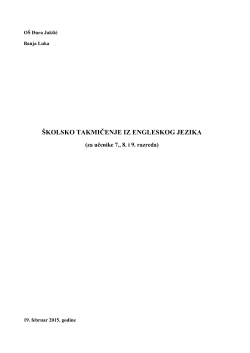
The Buffalo as a nourishing meat for consumption
International Journal of Animal Science, Husbandry and Livestock Production ISSN: 2141-5191 Vol. 2 (3), pp. 149-153, March, 2015. Available online at www.advancedscholarsjournals.org © Advanced Scholars Journals Review The Buffalo as a nourishing meat for consumption Modi Ravi Department of Animal Science, Faculty of Agricultural Science, Kumaun University, Nainital, India. E-mail:ravimodi@gmail.com Accepted 05 February, 2015 Indian sub-continent is the home tract of world buffaloes. Buffalo is the only potential animal that can boost meat industry in India. Buffalo meat is the healthiest meat among red meats known for human consumption since it is low in calories and cholesterol. Buffalo meat is well comparable to beef in many of the physicochemical, nutritional, functional properties and palatability attributes. Meat from buffalo is called by various terminologies in different countries according to the age of slaughter. Buffaloes have a unique ability to utilise coarse feeds, straws and crop residues converting them into protein rich lean meat. The carcass composition varies with dressing percentage of buffalo carcasses. The dark buffalo meat possesses good binding properties and is preferred in product manufacture. Buffalo meat is the major item of Indian animal product export. Adequate nutrition and improved levels of hygiene at meat handling will enable India a quantum jump in meat production by utilizing the surplus male calves. Massive developmental programmes have to be launched to produce meat as the principal commodity from buffaloes for substantially increasing the livestock economy of the country. Key Words: Buffalo, food animal, carabeef, black gold. INTRODUCTION Buffaloes have descended from arni or wild Indian buffalo. Indian sub-continent is the home tract of world buffaloes. Buffaloes are of two types, riverine buffalo (Bubalus bubalis) and swamp buffalo (B. bubalis). Riverine buffaloes are distributed in India, Pakistan, Sri lanka and some European countries such as Italy, Bulgaria, Greece and Yugoslavia. Swamp buffaloes are spread in Far East Asia including China, Indo-China, Indonesia, Philippines and Thailand (Ross, 1975). India has largest livestock population in the world. It has about 98 million buffaloes, which is 57% of total population in the world. They contribute to 1.48 million metric tonnes of meat, amounting 24.54% of the total meat produced in the country (FAO, 2008) . Buffalo is the only potential animal that can boost meat industry in India. Buffalo meat is the major item of Indian meat export generating huge revenue in animal products sector. Buffalo meat is the healthiest meat among red meats known for human consumption because it is low in calories and cholesterol. It has almost 2-3 folds cost advantage over mutton and goat meat. In India, meat is consumed either in curry form with high spices or as processed meat products. Only 2% of the meat is proce- ssed in India (APEDA, 2008), the remaining meat is sold in fresh or frozen form. Despite vast resource of population and contribution of buffaloes to the total meat production in the country, their potential for utility in the processed meat sector is not completely exploited. Alternative livestock for meat Buffalo meat has gained importance in the recent years because of its domestic needs and export potential. Buffalo meat is well comparable to beef in many of the physicochemical, nutritional, functional properties and palatability attributes (Anjaneyulu et al., 1990). Furthermore, its utility in meat processing is on increase because of higher content of lean meat and less fat. Buffalo meat terminologies Buffaloes are raised for meat particularly in countries like Italy, Bulgaria, Czechoslovakia, Russia and Egypt. Meat from buffalo is called by various terminologies in different countries according to the age of slaughter. The term, Modi 150 Table 1. Composition of buffalo meat. Particulars Buffalo meat Buffalo broiler Water (%) Protein (%) 74 -78 76.89 20.2 -24.1 22.46 Fat (%) 0.9 -1.8 0.35 buffalo meat, is named after species of origin, most appropriate and common terminology used in Indian context. Buffalo beef is a differentiating nomenclature from its close ally, beef. Carabeef (seldom called buffen) is derived from the term caraboa, popular name for swamp buffalo in Thailand, Philippines and some South East Asian countries. Buffalo veal is the meat from male buffalo calves. Buffalo broilers are the buffalo calves reared exclusively on milk for meat purpose or with established norms of slaughter weight against a welldefined tender age (Ross, 1975; Bhat and Lakshmanan, 1998). Inherent qualities as meat producer Buffaloes have a unique ability to utilise coarse feeds, straws and crop residues converting them into protein rich lean meat. Hence buffaloes fit well in poor countries having poor feed resources (Arganosa, 1973). Buffalo properly managed and fed as a meat producing animal and slaughtered at 16 to 20 months of age yields a highly satisfactory top quality meat at a much lower cost than the cattle (Ranjan and Pathak, 1979). Since buffaloes have been used as draught animals for centuries, they have evolved with exceptional muscular development. Until recently, little thought was given to use them exclusively for meat production. Buffaloes are lean animals. The sub-cutaneous fat layer of the carcass is usually thinner than that on comparably fed cattle. Fat is low even under feed lot conditions (Desmond, 1990). More lean and less fat compared to cattle, has created a demand for it among health conscious consumers (Kondaiah, 2002). Buffaloes have higher degree of resistance and tolerance than cattle against many diseases (Ross, 1975) . They are reasonably productive up to 15 years of age. At 18 years and even more may produce calves (Banerjee, 1998). Buffaloes have ex-cellent body weight gain compared to other species. The nutrient requirements of buffalo steer include 0.24 Kg DCP, 1.8 Kg TDN, 6.6 MCal ME, 14 g Ca, and 11 g P. On adlibitum and high concentrate (75:25) based rations the growth rate is 610 g/day with feed efficiency of 7:1. On all roughage rations (Green berseem/ berseem hay) the growth rate is 370 g/day with feed efficiency of 10:1 (Ranjan and Pathak, 1979). Dressing percentage and carcass composition Young male buffaloes are usually slaughtered at 12-24 months when they weigh 250-300 kg (Baruah et al., 1990). The dressing percentage varies with age and type Ash (%) 1.0 0.3 Cholesterol (mg %) 61 - Energy (Kcal/100g) 131 - of animal slaughtered. Mediterranean-type (Brazil) of buffalo yields a dressing percentage of 55.51. Swamp buffalo (Australia) yields 53.0%. Old and unproductive buffaloes yield 43-57%. Average dressing percentage on moderate diet is about 55.4-59.0. Buffalo veal yields about 61-64% (Ross, 1975; Bhat and Lakshmanan, 1998). The carcass composition varies with dressing percentage of buffalo carcasses. A buffalo having dressing percentage of 43-44 is composed of 65-70% meat, 510% fat and 20-24% bone. A buffalo broiler having a dressing percentage of 51.4 constitutes 66.8% meat, 9.7% fat and 23.5% bone (Joksimovic and Oqnjanovic, 1977; Bhat and Lakshmanan, 1998; Sharma, 1999). Thus, buffalo carcass has rounder ribs, a higher proportion of muscle and a lower proportion of bone and fat than beef. Physicochemical attributes of buffalo meat Buffalo meat is dark red in colour, firm in consistency with white fat colour (Joksimovic and Oqnjanovic, 1977). More pigmentation or less intra muscular fat (1-2% marbling compared with 3-4% in beef) content causes darker appearance of buffalo meat. The dark meat possesses good binding properties and is preferred in product manufacture (Kondaiah, 2002). -carotene in the fat gives yellow colouration and is totally absent in buffalo fat (Joksimovic and Oqnjanovic, 1977). As evident from Table 1, Buffalo meat constitutes higher protein, low fat and cholesterol (Arganosa, 1973; Ross, 1975; Joksimovic and Oqnjanovic, 1977; Anjaneyulu et al., 1994; Kandeepan and Biswas, 2007). Buffalo production systems existing in other major buffalo producing countries There are approximately 27.3 million buffaloes in Pakistan (Livestock Census, 2006) which puts Pakistan nd at 2 position after India. Under Pakistani conditions buffaloes are kept under different production set ups including 1) grazing systems, where animals depend on grazing in open grasslands or lands not suitable for cropping, 2) mixed farming system, in which fodders, crop residues, agro industrial by products and weeds in cropland after harvest are used as animal feed, and 3) peri-urban dairy colonies, where buffaloes are kept under better feeding, managemental conditions and a good veterinary cover (Devendara, 2001). A total of 3.34 million buffaloes are slaughtered annually amounting 0.509 151 million tonnes of meat. The estimated share of buffaloes in the red meat supply is about 32%. The culled buffaloes (mainly because of low milk yield, reproductive failures and old age) and surplus males are continuously taken to North Western Frontier Provinces from Punjab and even to Afghanistan for meat purpose. Surplus male calves are an important source of meat in the country. Young males are also used as sacrificial animals at occasions such as Eid-ul-Azha. In the Philippines there are 3.2 million Carabao buffaloes. The Carabao Development Programme is a massive programme started in 1993 to improve the native Swamp buffalo locally known as the Carabao to develop their meat, milk and draught potential. In Indonesia, buffaloes are commonly tethered by the roadside, and in such cases, feed is cut and carried to them. Alternatively, they may be herded to "waste" areas where they graze on crop residues, and feed supplements are rarely given in sufficient quantities. The Vietnamese buffaloes are of the Swamp type with a total population of nearly three million. In general, Vietnamese Swamp buffaloes have a small body size, a slow growth rate and late maturity. There are two buffalo production systems distinguished, namely an extensive and a semiintensive system for draught and meat production. About 3% of the total domestic meat consumption is from buffalo meat; about 35% of the meat provided by large ruminants is from buffaloes (Ly, 2001). Buffaloes are usually slaughtered, when they are too old for draught or lose their ability to work by an accident (Tuyen and Ly, 2001). Buffaloes are culled at around 12 to 13 years age. Currently, buffalo meat earns a lower price than beef due to consumers perceptions and traditional thinking (Ly, 2001). Surplus culled buffaloes, particularly females with low reproductive performance and aggres-sive males of 6 years age or older are exported to the neighbouring countries such as China, Laos and Thailand for meat (Eguienta et al., 2002). In Bangladesh, buffaloes are raised under a semi-intensive system on plain land and marshy land where there is limited pasture land. An intensive system for buffalo production is not practiced anywhere even for institutional herds. The staple food for buffaloes is rice straw, which is an inadequate source of energy and protein. Sugarcane leaves, micro silage of sugarcane leaves, cassava leaves, roadside grass, elephant grass, and maize with corn cob and pineapple bran are also used as feeding stuffs (Faruque, 2003). Approximately 83% of Thailand's buffaloes live in the Northeast where most agricultural production is under rainfed conditions. Most of Thailand’s buffalo production could be referred to as backyard, subsistence production. The buffaloes do not graze on specific pasture nor are feed supplements given, rather a more traditional “cut and carry” or tethered grazing system is used. Hence meat production per se is not the primary focus of these farmers. Int. J. Ani. Sci. Husbandry. Livestock. Prod. In Malaysia, formula for the fattening of buffalo calves using local feedstuffs, such as oil palm and rice by-products, have been devised in order to obtain a high average daily weight gain. Swamp buffaloes raised on feedlots using oil palm by-products as the major feed ingredient can reach a normal growth rate of about 0.59 kg per day and age at puberty was significantly lower in bulls on intensive grazing (21.5 months) than in bulls on free grazing (28 months) systems (Jainudeen et al, 2000). Quality improvement of spent buffalo meat Most of the buffaloes are slaughtered at end of their productive or working life and therefore, the meat is dark, coarse and tough. Now-a-days, consumers are demanding quality meat with more emphasis on tenderness which is often not obtained from the aged and spent animals. As a consequence, majority of the meat is losing its popularity and demand. Some quantity of meat produced is used for development of various comminuted meat products. Practical methods for improving tenderness of such meat to an acceptable level would definitely increase retail value and marketing opportunities. Freezing of adult male buffalo meat improved texture, tenderness and juiciness scores during prolonged storage (Kandeepan and Biswas, 2007) . Electrical stimulation of buffalo carcasses significantly improved sensory tenderness scores. The tenderness improvement of more than 32% was observed in electrically stimulated carcasses (Biswas et al., 2007). High voltage electrical stimulation (700 V, 1400 V peak, pulses 1 s on/1 s off, 60 Hz, 2 A) on buffalo carcasses resulted in a significantly higher tenderness scores and myofibril fragmentation compared to non-stimulated controls, irrespective of the cooling process adopted (Soares and Arêas, 1995). Ground buffalo meat from spent females treated with 500 ppm sodium ascorbate significantly increased the pH, colour, odour and chroma but decreased cooking loss, metmyoglobin and TBARS number (Sahoo and Anjaneyulu, 1997a). Use of 10 ppm tocopherol acetate for preblending extended the shelf life of ground buffalo meat from 6 to 8 days under refrigerated storage (Sahoo and Anjaneyulu, 1997b). Use of 1.0% carnosine for preblending extended the shelf life of ground buffalo meat up to 8 days under refrigerated storage (Das et al., 2006). Meat chunks from spent buffaloes marinated with 2% (w/w) powdered cucumis extract and 5% (w/v) ginger extract for 48 h at 4°C significantly (P<0.01) improved the flavor, juiciness, tenderness and overall acceptability scores (Naveena et al., 2004). Export potential of buffalo meat Meat export is desired to effectively utilize the available livestock resources and improve returns to the farmers by Modi 152 popularizing buffalo meat. Buffalo meat is the major item of Indian animal product export comprising 48.76% of the total animal products exported. The major destinations of buffalo meat include Malaysia, USA, Jordan, Oman and UAE. Buffalo meat is exported to the tune of 306970.81 MT amounting 1615.59 crores which is the highest among all animal products that are exported form India (APEDA, 2008). The share of Indian meat exports in the world market is less than 2%. Adequate meat production potential exists in the country to meet the domestic demand and to substantially increase the export. A significant price differential between domestic and export market exists for buffalo meat and it has better prospects for the meat traders. For an instance, In Bareilly district, Uttar Pradesh, India the buffalo meat is sold by the retailer at the rate of Rs.40/kg. Whereas, the same meat used for export purpose fetches Rs.60/kg at the municipal slaughter house. industries, meat corporations, research workers and nodal bodies like APEDA (Agricultural and Processed food products Export Development Authority) and Directorate of Marketing and Inspection (DMI) for exchange of information and overall improvement of meat industry and national economy. Government should make efforts to upgrade municipal slaughter houses to semi modern abattoirs with all basic requirements and minimum hygienic standards. In the present context of WTO agreement on sanitary and phyto-sanitary (SPS) measures, the hygienic standards of existing meat plants should be improved and made at par with the best in the world. The control measures for FMD should be strengthened and adequately controlled areas should be declared as disease free zones to stabilize export market by producing meat for export from such areas. The Government should encourage setting up cold storages, supply/value chain and 100% export oriented buffalo slaughter houses in major buffalo belts of the country. Strategies to ameliorate buffalo meat industry Survey projects on production and marketing may be deployed as base material for projection at national and international levels, for the prediction of future trends and for the formulation of meat industry developmental programmes. Meat scientists and animal geneticists should collaborate their research aiming at developing a potential cross bred buffalo for meat purpose. Research projects on buffalo meat technology should focus on working slaughter grades of buffaloes as in USDA for beef. Buffalo meat affords an easy means of preparing low priced fast meat foods by restricting the cost of raw material. So, the focus area of research should be low cost ready to eat buffalo meat products. The other area is to design appropriate technologies to improve the quality of meat from spent animals. Research should focus on extension of self life of traditional buffalo meat products available in our country and making necessary efforts for patenting them. The Government should encourage and give subsidies/incentives to start meat and by-products processing industries. Increasing the production of superior calves through embryo transfer technology, better disease control, adequate nutrition and improved levels of hygiene at meat handling will enable India a quantum jump in meat production by utilizing the surplus male calves. Financial institutions should come forward to finance activities related to buffalo meat trade. Appropriate consumer education programmes on popularization of quality and health benefits of buffalo meat and products will provide a cheap source of animal protein to the masses. The demand for buffalo meat products will serve as a catalyst for all developmental programmes on buffalo meat production. A very strong rapport must be built between liaison offices, meat Conclusions The potentialities of buffaloes as food animals to meet present and future demands of rapidly growing population deserves special attention because of its capacity to convert economically course roughages and other cereal by-products into meat. The innate potential of buffaloes, especially the value of male calves is fast gaining momentum. Buffalo is the chief foreign exchange earner in meat sector. By just initiating developmental programmes on buffalo veal production, India is poised to nearly double its meat production. India, the birthplace for every second buffalo in the world, is expected to provide leadership in buffalo husbandry. The key role played by buffaloes in improving dairy industry in India can well be repeated in meat industry, if only available knowledge and ideas are crystallized into action plans. The time is quite ripe for launching massive developmental programmes to produce meat as the principal commodity from buffaloes for substantially increasing the livestock economy of the country. REFERENCES Anjaneyulu ASR, Lakshmanan V, Sharma N, Kondaiah N (1990). Buffalo meat production and meat quality: A review. Indian Food Packer, 44(4): 21-31. Anjaneyulu ASR, Sharma N, Kondaiah N (1994). Effect of salt and its blend with polyphosphates on the quality of buffalo meat and patties under hot, chilled and frozen conditions. J. Food Sci. Technol. India 31(5): 404-408. APEDA (2008). Export of agro and processed food products including meat and meat products. Agricultural and Processed Food Products Export Development Authority. Ministry of Commerce, Government of India. Arganosa FC (1973). Evaluation of carabeef as a potential substitute for beef. Philippines Journal of Nutrition 26(2): 128-143. Banerjee GC (1998). Buffaloes. In: A Textbook of Animal Husbandry. th 8 edition pp. 699-700, 711-712. 153 Baruah KK, Ranjan SK, Pathak NN (1990). Effect of dietary protein and energy levels on the carcass characteristics of male buffalo calves. Buffalo J. 6(1):11-16. Bhat PN, Lakshmanan V (1998). The Buffalo meat Industry in India. An st over view. In: Buffalo prod. health. 1 publication. ICAR pp. 185-214. Biswas S, Banerjee R, Chakraborty A, Borpuzari RN (2007). Effect of electrical stimulation on carabeef quality. J. Food Sci. Technol. 44: 487-490. Das AK, Anjaneyulu ASR, Biswas S (2006). Effect of carnosine preblending on the quality of ground buffalo meat. Food Chem. 97: 531-538. Desmond H (1990). Cattle and Buffalo Meat Production in the Tropics. st 1 edition pp. 180-204. Devendara C (2001). Small dairy production systems in developing countries: characteristics, potential and opportunities for improvement. Asian Aust. J. Anim. Sci. 14: 104–13 Eguienta YK, Martin C, Lecomte P, Husson O, Castella JC (2002). Crop-livestock interactions in northern Vietnam: Issues, diversity of farmers' responses, and alternatives for sustainable integration of animals in upland agricultural systems. In: Castella, JC and Quang, DD (Eds.), 2002. Doi Moi in the Mountains. Land use changes and farmers' livelihood strategies in Bac Kan province, Vietnam. The Agricultural Publishing House. Hanoi, Vietnam, pp 221-247. FAO (2008). The state of food and agriculture. Food and Agriculture Organisation, Rome. http://apps.fao.org.page/collection. Faruque MO (2003). Buffalo production system in Bangladesh. Proceedings of the Fourth Asian Buffalo Congress, New Delhi, India, 25 to 28 Feb.: 31-35. Jainudeen MR, Wan Zahari M (2000). Buffalo production in Malaysia. Proceedings of the Third Asian Buffalo Congress, Kandy, Sri Lanka, 27 to 31 Mar.: 81-84. Joksimovic J, Oqnjanovic A (1977). Comparison of carcass yield, carcass composition and quality characteristics of buffalo meat and beef. Meat Sci. 1(2):105-110. Kandeepan G, Biswas S (2007). Effect of domestic refrigeration on keeping quality of buffalo meat. J. Food Technol. 5(1):29-35. Kondaiah N (2002). Meat and by products.In: Handbook of Animal rd Husbandry. 3 revised edition. pp. 950-975. New Delhi, India: DIPA, ICAR. Int. J. Ani. Sci. Husbandry. Livestock. Prod. Livestock Census (2006). Agricultural Census organization, Statistic Division, Govt. of Pakistan, Gulberg, Lahore. Ly LV (2001). Buffalo development in Vietnam. Constraints and prospects. Workshop on Swamp Buffalo Development, December 17 to 18, 2001. Hanoi, Vietnam. Naveena BM, Mendiratta SK, Anjaneyulu ASR (2004). Tenderization of buffalo meat using plant proteases from Cucumis trigonus roxb (Kachri) and Zingiber officinale roscoe (Ginger rhizome). Meat Sci. 68: 363-369. Ranjan SK, Pathak NN (1979). Management and Feeding Of Buffaloes. pp 217-227. New Delhi, India: Vikas Publishing House. Ross C (1975). Alternative Livestock: with particular response to the st water buffalo (Bubalus bubalis).In: Meat. 1 publication pp. 507-524. Sahoo J, Anjaneyulu ASR (1997a). Quality improvement of ground buffalo meat by preblending with sodium ascorbate. Meat Sci. 46: 237-247. Sahoo J, Anjaneyulu ASR (1997b). Effect of natural antioxidants and vacuum packaging on the quality of buffalo meat nuggets during refrigerated storage. Meat Sci. 47: 223-230. st Sharma BD (1999). Meat and Meat Products Technology. 1 Edition pp. 1-22. New Delhi, India: Jaypee Publications. Soares GJD, Arêas JAG (1995). Effect of electrical stimulation on post mortem biochemical characteristics and quality of Longissimus dorsi thoracis muscle from buffalo (Bubalus bubalis). Meat Sci. 41: 369379. Tuyen DK, Ly NV (2001). The role of swamp buffalo in agricultural production of small farm holder. Workshop on Swamp Buffalo Development, December 17 to 18, 2001. Hanoi, Vietnam.
© Copyright 2025









